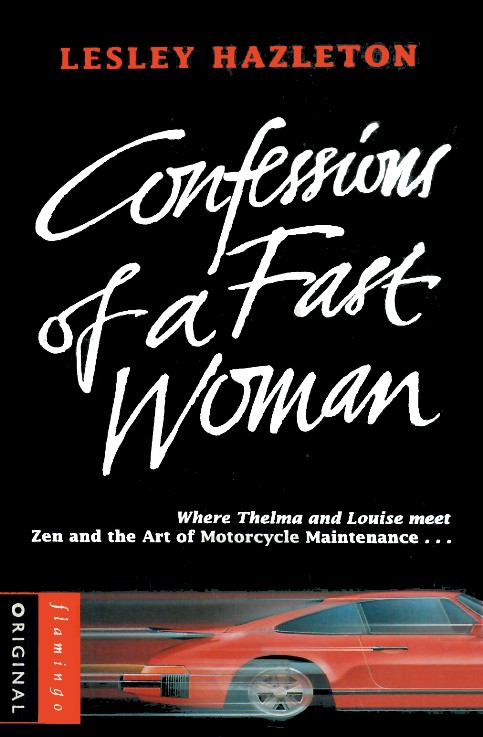Book Review by Hugh King (Chairman, AMHF)
SUNRAYCER and the World Solar Challenge 1987
By the late Bill Tuckey (1936-2016), former editor of Wheels and prolific motoring author; photography by Ray Berghouse. Chevron Publishing, Sydney 1989: ISBN 1 875 -21-01-8 (out of print; from Amazon).
CONFESSIONS OF A FAST WOMAN
By Lesley Hazleton, motor mechanic and journalist, New York Times, Lear’s Magazine USA. HarperCollinsPublishers. London 1992: ISBN 0-00-654579-1 (out of print; from eBay).
Darwin to Adelaide – the 1987 BP World Solar Challenge, six hard days and 3200 kms down the Stuart Highway, each car powered by nothing but the solar rays on the eight square meters of photovoltaic cells. An international cast of constructors and drivers attracting nation-wide media coverage as we saw “the future of motoring” tested on a legendary route. Australian race driver John Harvey steering the winner over the line at the Adelaide Oval a few days before the third running of the Adelaide Grand Prix. And that winner by a big margin was the all-electric GM Sunraycer developed by a small US independent engineering group working with General Motors-Hughes Corporation, backed by Chairman Roger Smith with money no object. It was a project supported in Australia by the engineers at GM-Holdens, one of whom, Ray Borrett was on the team of six drivers who along with John Harvey wheeled the little car silently through the outback well ahead of the pack.

In 1987 the concept of a reliable and speedy all-electric world of transport was beyond the realm of commercial possibility.
But the importance of the Challenge can be judged now best with hindsight. Seeing the list of entrants now – from Ford, Daimler-Benz, GM, Mitsubishi, Nissan, Honda, Mazda in addition to five American and some Australian universities and privateers – we understand that this nation then was the stage on which major US European and Japanese vehicle manufacturers displayed and tested their best ideas of the time and determined their future strategies which led to the all-electric and hybrid vehicles now on the roads.
The whole solar challenge project was conceived by Hans Tholstrup and Larry Perkins some five years earlier as they constructed then drove a solar-powered car The Quiet Achiever across Australia from Perth to Sydney. Tholstrup ‘sold’ the idea to GM’s Roger Smith in 1986 and subsequently was appointed Organiser and Director of his brainchild, the World Solar Challenge of 1987.
Thirty years gone, and this important part of Australia’s motor heritage can be revisited through the remarkable and lasting work of Bill Tuckey. He was commissioned be on site and to write the full story of GM’s involvement and of the competition itself, which he titled simply Sunraycer. The photography by publisher Ray Berghouse and his team captures the whole saga of GM’s work on the project. That well-written work is a detailed amusing and complete first source for information on the event, particularly from the GM perspective. It clear that Tuckey and his colleagues enjoyed a convivial time. It was also covered by him well in Wheels.
The development of Sunraycer was entrusted by GM-Hughes to Dr Paul MacReady the head of AeroVironment, a small (100-person) specialist engineering group which designed the power systems. chassis and aerodynamics of the cockroach-shaped little vehicle. Journalist Lesley Hazleton was an observer throughout the Challenge and Dr MacReady as the Project Manager enabled her access to some of the more hidden aspects of his work with GM-Hughes, and of the event itself.
In her autobiographical book Confessions of Fast Woman Hazleton gives her personal views on the significance of the World Challenge as it affected the direction and intentions of US manufacturers, including GM-Hughes in the five years up to the date of her writing (1992). For the time, this is an insightful piece of work.
At one point she writes – “The race was over, but despite its success, few of those who had taken part in it expected solar cars to replace gasoline cars in anything like the near future. That’s not why Paul MacReady was there. It’s also not why Honda, Nissan, Mazda and General Motors were there, or why Volkswagen, Ford Daimler-Benz and other major manufacturers had given technical help and back-up to many of the teams.
The fact is that the solar cars charging their batteries in the Australian sun were not, as might seem at first, mere well-meaning gestures of environmental idealism, but mobile labs of advanced electronic technology representing hundreds of millions of research-and-development dollars.

This was a high-stakes race for the future. And these solar cars were research vehicles for the development of a whole new era in automotive technology. It was a race to determine the future of the car…”.
Now we can echo, ‘Of course it was!’. But we see the historical relevance. It is because of authors such as Bill Tuckey, along with journalists like Leslie Hazleton that we in Australia can now understand how our local automotive manufacturing industry stood tall at the crossroads of progress just thirty years ago, in its very own back yard and with super publicity, and then went its own way. Australia’s later trajectory on vehicle manufacture did not align with opportunity then.
(Both these books, and the associated relevant periodicals of the time, can be viewed in the AMHF’s library of resources in due course).

